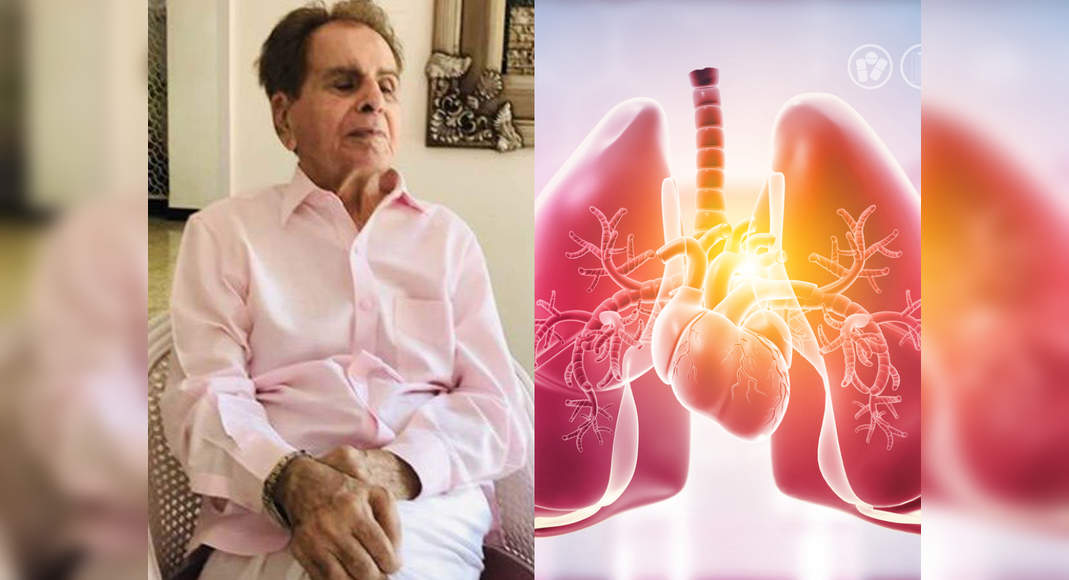Veteran actor Dilip Kumar was admitted to Hinduja Hospital, Mumbai on Sunday.
As per the reports, he has been diagnosed with bilateral pleural effusion and is on oxygen support in ICU.
Though his condition is now stable.
The actor was hvaing trouble breathing for the past two days after which he was hospitalised.
The actor’s health update was also shared on his official Twitter handle.
“Don’t believe in WhatsApp forwards.
Saab is stable.
Thank you for your heart-felt duas and prayers.
As per doctors; he should be home in 2-3 days.
Insh’Allah.”
Here is everything you need to know about bilateral pleural effusion:
What is pleural effusion?
Pleural effusion is the collection of an unusual amount of fluid around the lungs.
It is said that there are many medical conditions that can lead to it.
Though the doctors drain the pleural effusion, they primarily target the treatment at whatever caused it.
Pleura is a thin membrane that lines the surface of your lungs and the inside of your chest wall.
When one gets pleural effusion, fluid builds up in the space between the layers of your pleura.
Normally, there is only teaspoons of watery fluid in the pleural space, which allows the lungs to move smoothly in the chest cavity when you breathe.
What causes pleural effusion?
There are various medical conditions that can cause pleural effusions.
But some of the most common conditions include:
Leakage from the organs
This happens when a person has congestive heart failure and the heart doesn’t pump enough blood to your body properly.
But this can also come from liver and kidney diseases, when the fluids build up in your body and leak into the pleural space.
Cancer
Lung cancer can also cause pleural effusion, but other cancers that have spread to the lungs or the pleura can also lead to it.
Infections
Tuberculosis and pneumonia can also cause pleural effusion.
Autoimmune conditions
Lupus or rheumatoid arthritis are some autoimmune diseases that can lead to the condition.
Pulmonary embolism
Blockage in an artery in one of the lungs can also be the reason.
Common symptoms
It is quite possible that some people may not report any symptoms in the initial stage.
Symptoms are most likely to appear when the condition reaches moderate or large stage or if there is inflammation.
Symptoms may include:
– Shortness of breath
– Fever
– Cough
– Chest pain during breathing
Types of pleural effusion
Two main types of pleural effusions are transudative and exudative effusions.
Transudative
This is similar to the fluid people have in the pleural space.
It forms from liquid leaking across the normal pleura.
This is rarely required to be drained unless it’s very large.
Congestive heart failure is the most common cause of transudative effusion.
Exudative
This forms from extra liquid, protein, blood, bacteria and inflammatory cells.
This has to be drained, depending on the size and the inflammation.
The cause of this includes pneumonia and lung cancer.
Diagnosis
A doctor will tap on your chest and listen with a stethoscope.
Imaging tests are required to confirm if you have pleural effusion.
Chest X-ray
Pleural effusions appear white on an X-ray, while the air space looks black.
Computed tomography (CT scan)
A CT scan takes multiple X-rays quickly and a computer constructs the images of the entire chest, inside out.
CT scans show more details than X-rays.
Ultrasound
The doctor may use ultrasound to locate the fluid so they can get a sample for analysis.
Your doctor may also take a bit of fluid to test.
For this, they will insert a needle and a tube called a catheter between your ribs, into the pleural space.







